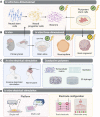Bioelectric Potential in Next-Generation Organoids: Electrical Stimulation to Enhance 3D Structures of the Central Nervous System
- PMID: 35656553
- PMCID: PMC9152151
- DOI: 10.3389/fcell.2022.901652
Bioelectric Potential in Next-Generation Organoids: Electrical Stimulation to Enhance 3D Structures of the Central Nervous System
Abstract
Pluripotent stem cell-derived organoid models of the central nervous system represent one of the most exciting areas in in vitro tissue engineering. Classically, organoids of the brain, retina and spinal cord have been generated via recapitulation of in vivo developmental cues, including biochemical and biomechanical. However, a lesser studied cue, bioelectricity, has been shown to regulate central nervous system development and function. In particular, electrical stimulation of neural cells has generated some important phenotypes relating to development and differentiation. Emerging techniques in bioengineering and biomaterials utilise electrical stimulation using conductive polymers. However, state-of-the-art pluripotent stem cell technology has not yet merged with this exciting area of bioelectricity. Here, we discuss recent findings in the field of bioelectricity relating to the central nervous system, possible mechanisms, and how electrical stimulation may be utilised as a novel technique to engineer "next-generation" organoids.
Keywords: CNS; bioelectricity; brain; electrical stimulation; organoids model; pluripotenct stem cells; retina.
Copyright © 2022 O’Hara-Wright, Mobini and Gonzalez-Cordero.
Conflict of interest statement
The authors declare that the research was conducted in the absence of any commercial or financial relationships that could be construed as a potential conflict of interest.
Figures





Similar articles
-
Advances in Central Nervous System Organoids: A Focus on Organoid-Based Models for Motor Neuron Disease.Tissue Eng Part C Methods. 2021 Mar;27(3):213-224. doi: 10.1089/ten.TEC.2020.0337. Epub 2021 Mar 3. Tissue Eng Part C Methods. 2021. PMID: 33446055 Review.
-
Bioengineering tools for next-generation neural organoids.Curr Opin Neurobiol. 2025 Jun;92:103011. doi: 10.1016/j.conb.2025.103011. Epub 2025 Mar 24. Curr Opin Neurobiol. 2025. PMID: 40132519 Review.
-
Toward the next generation of vascularized human neural organoids.Med Res Rev. 2023 Jan;43(1):31-54. doi: 10.1002/med.21922. Epub 2022 Aug 22. Med Res Rev. 2023. PMID: 35993813 Review.
-
Bioengineering tissue morphogenesis and function in human neural organoids.Semin Cell Dev Biol. 2021 Mar;111:52-59. doi: 10.1016/j.semcdb.2020.05.025. Epub 2020 Jun 12. Semin Cell Dev Biol. 2021. PMID: 32540123 Free PMC article. Review.
-
Bioengineering the human spinal cord.Front Cell Dev Biol. 2022 Aug 26;10:942742. doi: 10.3389/fcell.2022.942742. eCollection 2022. Front Cell Dev Biol. 2022. PMID: 36092702 Free PMC article. Review.
Cited by
-
Aberrant Retinal Pigment Epithelial Cells Derived from Induced Pluripotent Stem Cells of a Retinitis Pigmentosa Patient with the PRPF6 Mutation.Int J Mol Sci. 2022 Aug 12;23(16):9049. doi: 10.3390/ijms23169049. Int J Mol Sci. 2022. PMID: 36012314 Free PMC article.
-
Organoids - the future of pre-clinical development of AAV gene therapy for CNS disorders.Gene Ther. 2025 Mar 27. doi: 10.1038/s41434-025-00527-8. Online ahead of print. Gene Ther. 2025. PMID: 40148593 Review.
-
Brain organoid maturation and implantation integration based on electrical signals input.J Adv Res. 2025 Jul;73:375-395. doi: 10.1016/j.jare.2024.08.035. Epub 2024 Sep 5. J Adv Res. 2025. PMID: 39243942 Free PMC article.
-
Biohybrid neural interfaces: improving the biological integration of neural implants.Chem Commun (Camb). 2023 Dec 14;59(100):14745-14758. doi: 10.1039/d3cc05006h. Chem Commun (Camb). 2023. PMID: 37991846 Free PMC article. Review.
-
Extrinsic electric field modulates neuronal development and increases photoreceptor population in retinal organoids.Front Neurosci. 2024 Nov 29;18:1438903. doi: 10.3389/fnins.2024.1438903. eCollection 2024. Front Neurosci. 2024. PMID: 39678532 Free PMC article.
References
Publication types
LinkOut - more resources
Full Text Sources

